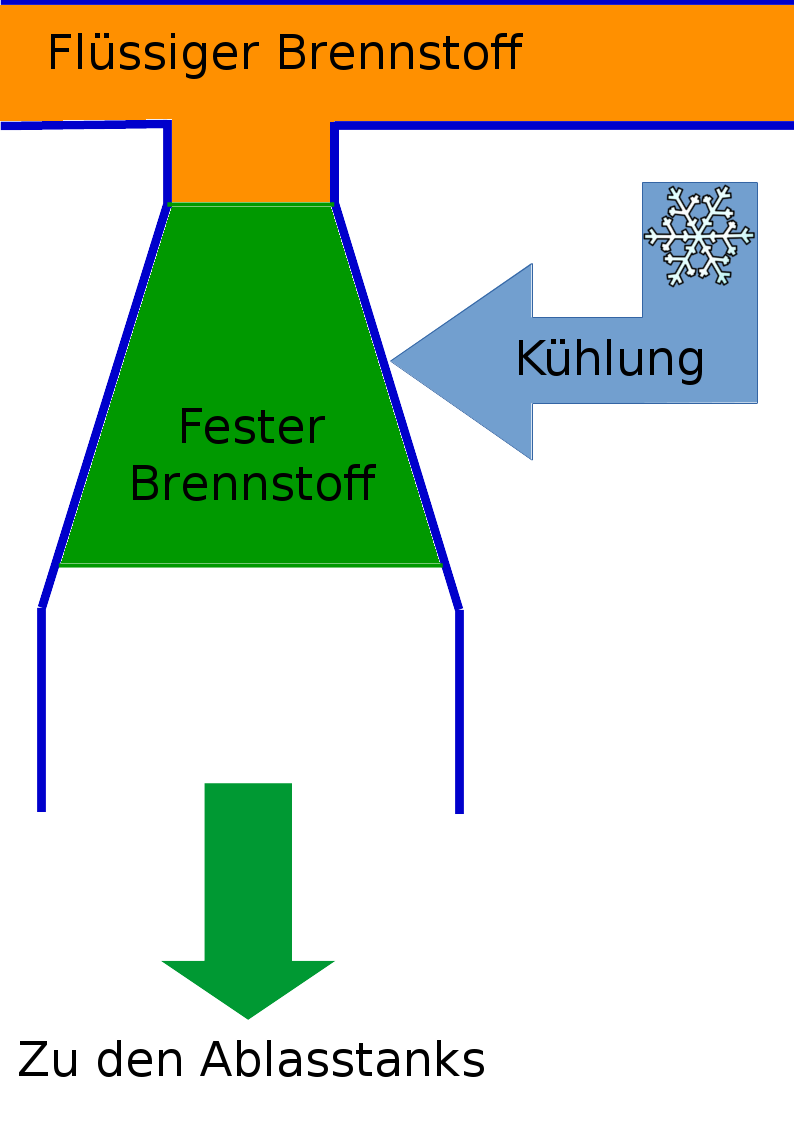Deterministic Safety
The safety concept of light-water reactors could be called stochastic safety: The probability of accidents causing harmful radiotoxicity release is pushed to very low values — while being still greater than zero. All power reactors currently in operation are equipped with layered safety mechanisms — from the charateristic domes, the purpose of which is to contain escaping steam in case of accidents, to diesel engines driving the cooling pumps when their regular power supply fails. Each of these can fail with a certain likelihood. Absolute safety can not be realized in that way.
The Dual Fluid Reactor was conceived from the get-go as a civilian energy source. Thus, deterministic safety is called for — the machines are intended to be installed in the vicinity of residential areas or industrial plants. Deterministic means: The probability of uncontrolled releases of radiotoxines is exactly zero. It follows from the reactor’s properties with mathematical precision that as long as the universe exists no event will take place leading to harmful increases of radiation levels outside of the plant — much like a glass of water resting on a table will not spontaneously start to boil or an object being accelerated towards earth’s center in the planet’s gravitational field — simply, because natural laws have a certain form.
In liquid fuels, expansion and contraction due to increase or decrease in temperature are much more pronounced than in solids. The DFR’s negative temperature coefficient is therefore far larger than that of solid-fueled reactors. The machine regulates itself, completely without mechanical control elements: It load-follows at constant temperature, which is predetermined by the concentration of fissile isotopes in the fuel. Thus, the DFR is inherently safe, to a higher degree than light-water reactors, as not only power excursions are avoided, but also control during normal operation occurs automatically.
In case of pump failure, molten lead will develop sufficient natural convection to remove decay heat from the reactor core — with the latter being far lower than in solid-fueled reactors anyhow, because fission products are constantly removed. The DFR is thus inherently as well as passively safe.
Hardly anyone would be scared of a biogas plant in his neighbourhood, in spite of there being a certain risk of explosion. A light water reactor is far less worrysome — a DFR, installed right next to a major city, poses less risk than a server farm. The greatest dangers would come from work accidents in the conventional part of the plant, comparably to other industrial plants or factories.
A nuclear analog Computer
In his book “Computers and the Imagination”, the writer and biochemist Clifford Pickover suggests an interesting, hypothetical scenario: What if scientists of the year 1900 were given a modern PC via timetravel? Pickover posed this question to a large number of collegues and collected the answers. Many of the scientists were convinced that a PC in the year 1900 would have caused enthusiasm at first — suddenly, solutions to everything would have seemed possible — and later disenchantment: Transferring real physical, technological, biological etc. problems into algorithms is not as simple as it may seem at a first glance. The universe works (as far as way know) in an analog way, being made up out of continuous quantities (except quantization in the microscopic world). Computers, on the other hand, use discrete storage values. The modeling of continuous systems through discrete data structures is such an ample topic as to demand a branch of science of its own: Numerical mathematics.
Engineers developing safety concepts for light-water reactors need to simulate the processes at work and write programs controlling it such that the nominal condition is maintained. To keep a LWR safe, a higher level of execution must be accessed: Part of the physical universe needs to be re-created in an electronic memory bank. It is impossible to do this without information loss, as the computer operates with a limited number of digits. Loss-free simulation is only possible with a computer modeling another computer of lower power — this is called emulation.
One should wish for a simpler and more robust safety mechanism working without information loss. This is only possible if the reactor is its own simulation computer — an analog computer controlling itself. This is exactly what the DFR does.
Three effects unite to yield a reactor which keeps its nominal temperature and adapts to the power extracted by itself without external control elements:
- Expansion/contraction of the fuel liquid upon heating/cooling.
- Temperature-dependent Doppler widening of the resonances of neutron capture cross sections.
- Changes in density of the neutron-reflecting liquid lead.
These effects make sure that upon temperature climbing beyond the nominal value the fission rate declines, and conversely rises if nominal temperature is undercut: Thus, a stable equilibrium is achieved. Nominal temperature is set by the Pyrochemical Processing Unit (PPU) via the concentration of fissile isotopes.
Emergency Shutdown by Melt Plugs
In the most extreme of emergencies, e.g. complete interruption of the cooling chain or a PPU malfunction adding too much fission fuel and thus setting nominal temperature to a value too high — even then the DFR remains safe. This is achieved through melt plugs, seals made of solidified fuel which are kept frozen by a cooling system running at maximum power. They are inside conical tube sections widening at the bottom: Even minuscule increases of temperature beyond nominal cause them to detach from the walls, upon which they are pushed downwards — the liquid fuel flows into storage tanks, shape and size of which suppress the chain reaction. Externally, the tanks are surrounded by steel ingots which serve as heat buffers and passively remove decay heat.
During the Molten Salt Reactor Experiment (MSRE), Weinberg and his team regularly shut down the reactor every friday evening in exactly this fashion: They cut power supply to the fan cooling the plugs, which then melted, sending the fuel into the tanks. Monday morning the salt, which by then had solidifed, was melted again and pumped back into the reactor.
Reactor safety is thus assured solely by thermodynamics and gravity. Natural laws will never fall asleep, fail to pay attention or be unreliable. As long as the universe lasts, a DFR will not cause an ultimate MCA — much like stones will not rise into the air or water freeze in scorching desert heat.
Protecting from external Damage
The DFR’s compact size makes it possible to install it in an underground bunker which is up to military standards. Internal malfunctions of any kind will not destroy the plant due to the laws of thermodynamics and gravity. Even a terrorist saboteur cannot outsmart physics. Destruction from the outside is possible — though only with modern burrowing bombs or nuclear bunker busters.
Nothing stands against setting up DFRs in industry centers or near major cities. Scenarios in which the health of human beings is endangered by escaping radiotoxins are no more likely than a person dying because all the oxygen in a room accumulates in one corner.
Further Information
Together with the KRITIKALITÄT society, our institute set up a website with lots of information about nuclear energy production and the associated risks: „Hundert guten Antworten” (One hundred good answers), where we disentangle myth and reality and dispel a number of rumors in an easy-to-understand format.



